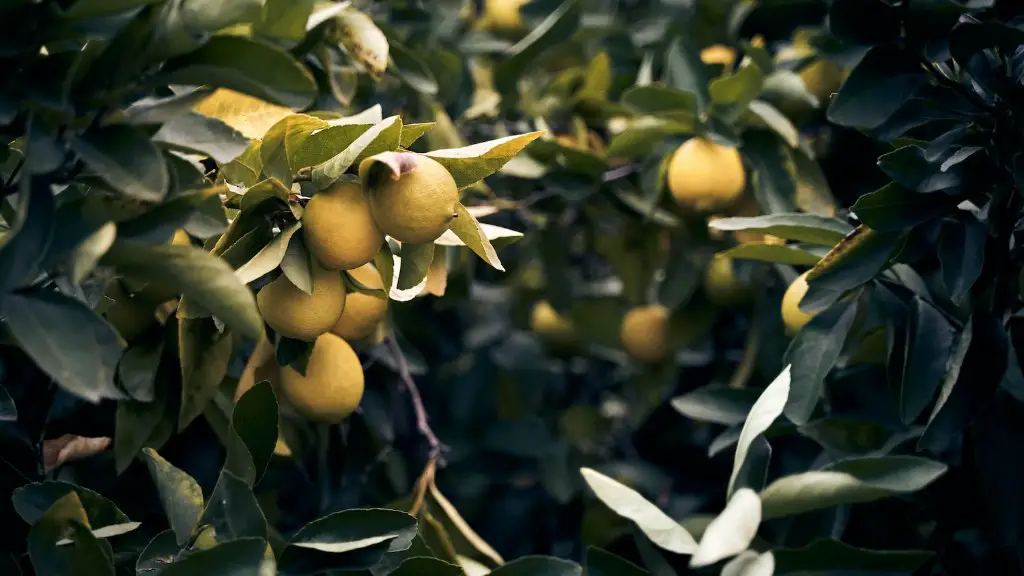Lemon trees are attractive and highly productive trees, producing large amounts of acidic, pearl-sized fruits that taste fantastic. But how long does it take for a lemon tree to bear fruit? This can vary depending on the variety of lemon tree, but the estimated time frame is usually 12-18 months post-planting. After this time, the tree will usually bear fruit at least twice per year.
In order to hasten fruit production and maximize the lemon tree’s yield, the tree should be fertilized every two months with a complete balanced fertilizer, complementing its natural nutrients. The fertilizer should contain at least three major nutrients, nitrogen, phosphorus, and potassium, and nitrogen should be the major component. Mineral and organic fertilizers are both suitable, although organic fertilizers are preferred because they produce healthier and long-lasting trees.
Furthermore, pruning the lemon tree is essential for optimal fruit production since it helps maintain a good shape, stimulates the production of buds, facilitates air circulation, and removes dead, weak or diseased branches. Pruning should be carried out in late winter (January-February) and may be done annually or every other year depending on the growth rate of the tree and its desired shape.
Another factor to consider is the amount of water the lemon tree needs for optimal growth. In general, the soil should be kept moist but never soggy. Lemon trees that do not receive enough water produce fewer flowers and less fruit, so it’s important to water them thoroughly at least twice a week in summer and once a week in autumn and winter.
The last and important consideration for lemon trees is the ideal growing environment for the tree. Lemon trees prefer full sunlight and thrive in warm, humid climates, preferably temperatures between 10-25 degrees Celsius. Trees planted in colder climates are likely to produce fewer fruits and may struggle to survive, especially during winter.
Harvesting and Yields
After the lemon tree has been established and is producing fruit, it’s important to harvest the fruit at regular intervals in order to maintain a sufficient supply of lemons. Most of the lemons should be harvested when they are still green since the rind is more aromatic and the fruits retain more juice. However, some of the lemons can be left to ripen and these will eventually turn yellow with a sweeter taste.
The expected yields of a lemon tree vary greatly depending on its variety, temperature, sun exposure, soil quality and other conditions. Some lemon trees may yield as little as 10-15 fruits per season, while others may produce 100 or more fruits per season. All in all, a productive lemon tree can provide an abundance of edible fruits for many years.
Care and Maintenance
For lemons trees to remain productive and healthy, proper care and maintenance should be provided throughout their lifetime. This includes fertilizing, trimming, and providing adequate water and sunlight. For daily maintenance, it’s important to monitor the tree and remove clumps of weeds that might accumulate around it as well as insect pests or signs of disease.
With annual pruning and regular fertilizing, lemon trees can remain productive for many years and produce a continuous yield of fruits. The soil should also be regularly inspected for nutrient deficiencies and amended as required. In addition, the trees should be kept free from pests or diseases by using insecticides or fungicides as necessary.
Pest and Disease Control
In order to keep lemon trees healthy, one should pay attention to pest and disease prevention. Common pests of lemon trees include mealybugs, spider mites, whiteflies, and citrus leafminers. Diseases of lemon trees may be caused by viruses, fungi, or nematodes. The best approach to pest and disease control is prevention through rigorous maintenance, pruning, and monitoring.
Where necessary, insecticides or fungicides can be used to control symptomatic pest or disease outbreaks as early as possible. However, it is important to note that chemical pesticides can kill beneficial insects and disrupt the balance of the ecosystem, so it is best to use them when strictly necessary. Additionally, biological insecticides and natural predators may be preferable for long-term pest control.
Fertilizing and Pruning
Fertilizing and pruning are two essential care practices for lemon trees. Both should be done on a regular basis in order to ensure optimal health and productivity. Fertilizers should be applied at least 2-3 times in a year and contain the proper ratios of nitrogen, phosphorus, and potassium, as well as trace elements such as zinc and iron. Pruning should also be done on a yearly basis, usually during winter, so that excess branches, dead wood, and diseased or weak branches are removed, while the desirable shape and size of the tree are maintained.
Pruning also helps to increase air circulation, promote flowering, multiple branching, and induce new growth. However, extreme caution should be used when pruning since an excessive amount of pruning will reduce the yield and vigor of the tree.
Glob Tips for Lemon Trees
When growing lemon trees, the following precautions should be taken: water sufficiently but avoid over-watering, apply organic and balanced fertilizers, avoid any type of chemical pesticide, and provide adequate air circulation by trimming branches and leaves regularly. Additionally, if the lemon tree is grown in cold climates, it is important to protect the tree from winter frosts with a net or tarp.
Finally, for a lemon tree to reach its optimum yield, it is important to provide adequate sunlight, soil amendment, and proper nutrients. With regular maintenance and the right environment, a lemon tree can provide a continuous supply of tasty, juicy fruits for many years.


